Menu
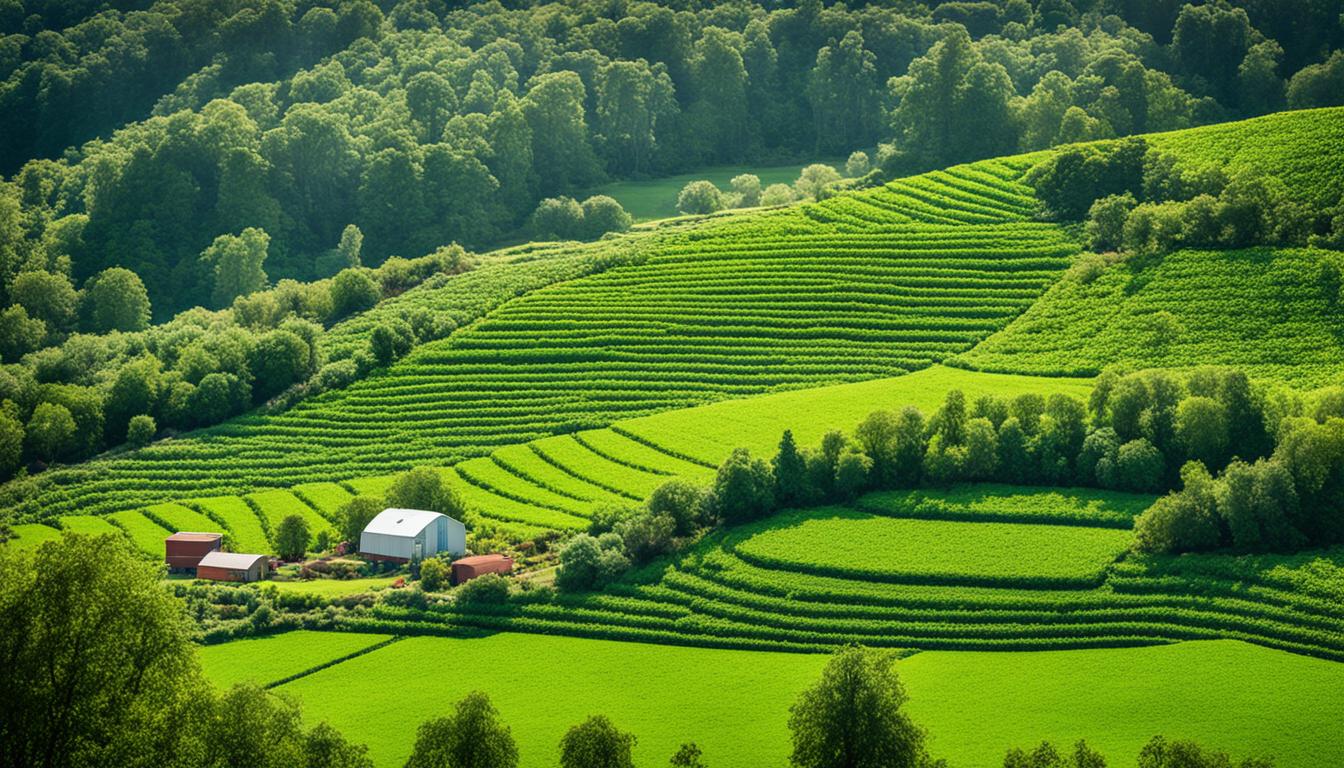
Walking through fields or standing in a forest, we connect deeply with nature. These moments highlight the fragile balance supporting life. However, with the human impact on Earth, we’ve turned a big part of it into farmlands. This means we need to farm in a way that enriches nature and protects our planet.
Over 1.1 billion people, depending mostly on farming, live in key areas for biodiversity. It shows our farm choices have a big effect. By adopting biodiversity-friendly farming methods, we can improve these places. Thus, our farms would become part of a rich, living pattern.
The Blended Learning Programme from the Global Landscapes Forum and Wageningen University opened my eyes. It taught me how to manage farms better for biodiversity. By understanding nature’s systems, we can farm in ways that meet global sustainability goals. It’s crucial we farm in tune with the Earth.
Studying how biodiversity helps our farms shows the problem we’re in. There are over 8.7 million species we know of. But many are at risk because of farming and other human actions.
Farming often leads to losing biodiversity. In the U.S., big farming turned 2.5 million acres of grasslands into crops in just a year. This hurts the animals and plants that should live there.
For example, tallgrass prairies have shrunk to 1% of their original size. This loss affects insects like monarch butterflies, making their numbers drop a lot.
Biodiversity is key for farm tasks nature does. But modern farming, with its too much use of chemicals, harms this. Wild plant species are dying off because of too many herbicides.
Monarch butterflies, who need these plants, are suffering. Also, pesticides like neonicotinoids damage bees, which hurts pollination and nature’s balance.
Preserving nature helps fight climate change. Techniques like regenerative farming do this. However, the need for more land for farming leads to cutting down rainforests.
The rapid loss of species and habitats from farming shows we must change. Protecting biodiversity is vital for our farms and nature. We must use farming methods that care for the earth and its creatures.
As we learn more about agriculture, we see it as a complex ecosystem. It has its own rules and ways of working. Exploring the ecological foundations of agriculture is key to farming that lasts and works with nature.

Almost a third of our land is used for growing crops or for animals to graze on. This shows why we need to know and use agroecology principles. Also, 10-20% of land is used for letting animals graze, affecting nature a lot.
Over the years, the amount of nitrogen we’ve added to the environment has shot up. With much of our water needed for farming already, we must find smart ways to farm.
Protecting biodiversity in farming is crucial, especially since so many people live in biodiverse areas. Pollution from farms in the US, flowing to the Gulf of Mexico, is harming sea life. This points to a real need for better farm care.
For instance, California has lost many wetlands due to farming. These losses remind us of the big impact farming can have on nature. We must make sure farming includes and protects biodiversity.
Mixing different uses with farming can help our environment. With more people wanting meat and dairy, farming must change. Also, as cities grow and people make more money, they might need more land to farm. This puts more stress on nature.
To avoid upsetting nature too much, we should use agroecology principles and smart farming methods. These can help us farm well without harming the environment. Policymakers should support these ideas to protect nature and our food supply for the future.
Transitioning to sustainable farming practices means moving from growing one plant to many. The old way was to grow a single crop over and over. But, switching to diverse systems helps both the environment and the farms.
Growing just one crop has its downsides. It makes farms more likely to suffer from pests and diseases. But, planting different types of crops creates varied habitats. This helps the soil and stops pests naturally.
Rotating different crops is key to farming sustainably. For the soil and nature to benefit, crops should be changed. For instance, planting beans after wheat can add nitrogen to the soil.
Such practices are very important because farming uses a lot of water. Plus, too much human-made nitrogen can harm our planet.
Cover crops are a great way to keep farms healthy and diverse. Plants like clover are grown when the main crops are not. They stop soil from washing away, keep water in the ground, and feed the soil. This method is essential for maintaining soil and ecosystems.
| Practice | Benefits | Impact on Biodiversity |
|---|---|---|
| Diverse Crop Rotations | Enhances soil fertility, breaks pest and disease cycles | Increases habitat variety |
| Cover Cropping | Prevents soil erosion, improves water retention | Supports soil organisms and pollinators |
Using diverse rotations and cover crops is a big step for farming sustainably. They make the soil and crops healthier. Plus, they bring back many species, making the whole farming system stronger.
Conservation agriculture techniques play a key role in promoting biodiversity in farming. They support sustainable farming and tackle ecological harm. As about a third of our land is for farming, we must consider how to farm smarter.
About 30% of our land is used for growing crops or as pastures. Adding conservation techniques can improve soil, keep more water, and help crops grow better. With so much land already in use, it’s crucial to use sustainable methods that encourage different plant and animal life.
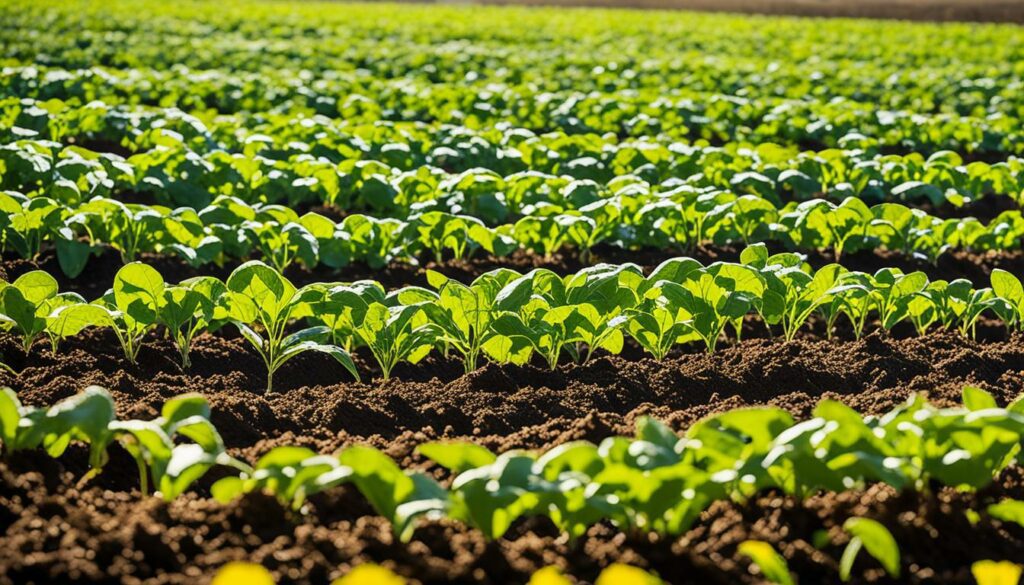
From what I’ve seen, keeping old crop parts and planting cover crops boosts life in the soil. It stops soil from washing away and makes it richer. Using less damaging methods to the soil keeps the natural balance, supporting various plant and animal species on farms.
Think about our need for food, given the growing population. By 2030, the Earth could have over 8 billion people. This makes it urgent to farm in ways that can feed everyone and protect wild areas.
We also need to manage water wisely. Farming uses up about 70% of the world’s freshwater. But ways to farm that reduce water waste help nature thrive. Plants that stick around for many years need less chemical help, which in turn, keeps water areas clean.
Biodiversity helps keep our crops safe and provides homes for many animals. These farming methods protect and encourage different species, making our farms stronger and more stable.
Between 1993 and 2020, the world’s love for meat is set to more than double. To handle this, we need sustained conservation efforts. Nature-friendly farming is the key to a future where the land and its creatures can thrive.
| Statistic | Value |
|---|---|
| Land used for agricultural crops | 30% |
| Land used for extensive livestock grazing | 10-20% |
| Freshwater used for agriculture | 70% |
| Projected global livestock product consumption rise | 303 to 654 million metric tonnes (1993-2020) |
In recent times, agroecology has become a key player in changing food systems. It integrates ecological ideas into farming, aiming for sustainability. Agroecology focuses on reducing the need for external inputs. Instead, it uses natural ways to control pests and improve farming. This reduces the use of harmful chemicals.
Using natural enemies to control pests is central in agroecology. This process lessens the need for harmful pesticides. It’s essential in farming that cares for biodiversity, which is vital for a strong agricultural system.
Agroecology systems work with a variety of life forms to make farming more efficient. The balance between different aspects is key. It supports the health of plants and the soil. This shows why a healthy ecosystem is crucial for growing food.
But agroecology is more than just controlling pests. It’s about changing how we raise animals and diversifying income in farming. This all-around method seeks to promote health for all – animals, people, and nature. It also helps farmers respond to what consumers want while staying true to their traditions and values.
| Agroecology Principle | Impact |
|---|---|
| Biological Pest Control | Reduces synthetic chemical use, promotes biodiversity |
| Input Reduction | Decreases dependency on purchased inputs |
| Soil Health | Enhances global food production |
| Economic Diversification | Increases financial resilience |
Using agroecology’s principles is key in the fight against hunger and poverty. As it grows, it becomes more and more vital for farming sustainably worldwide.
There’s a big demand for food around the world. This puts a lot of pressure on our farms. A third of the world’s lands are used for farming. This changes how nature works. But, we can help by farming in ways that use nature well. This means using natural things, not digging up the land too much, and making places where insects can live.
Farmers often use things like strong fertilisers and weed killers. But these can hurt the land and the water. Using things like compost instead can make the soil healthier. It also helps a lot of tiny living things in the soil. This is important as many people live in areas full of different plants and animals.
Not digging the soil too much is also good for nature. It keeps the soil from drying up and losing its shape. This is good because many wetlands have been changed by people. Doing this kind of farming helps the soil and the things that live in it to stay healthy.
Helping insects like bees is key for a healthy farm. By planting flowers near fields, there are more bees to help crops grow. This is vital for most farms which are always used for growing food. These areas become safe places for insects, making farms better for nature.
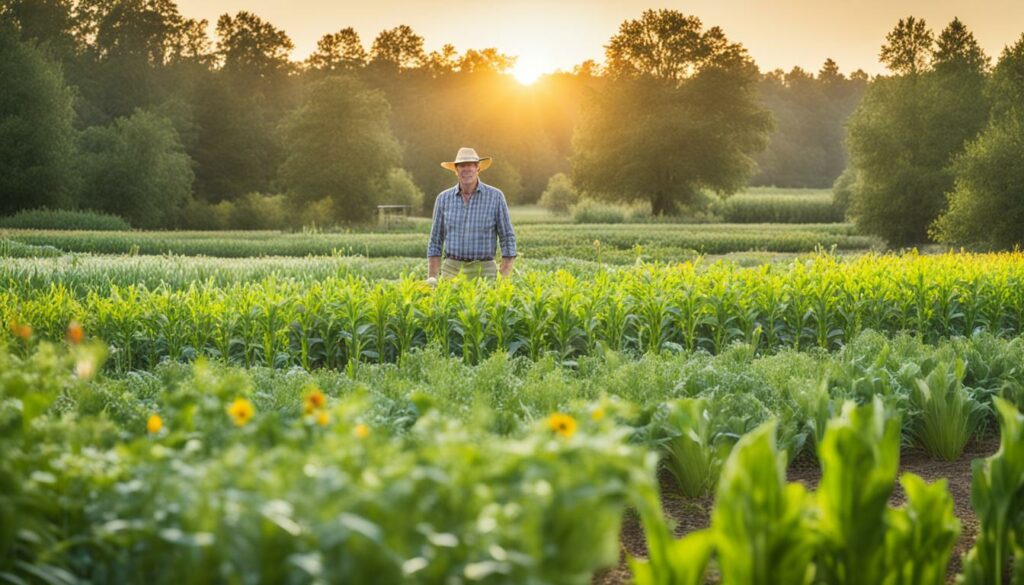
Using nature well, not digging too much, and making places for insects makes farming better. It helps the environment and allows us to feed more people. This is why it’s important to farm in ways that work with nature.
In today’s world, wildlife habitat conservation on farms is key. About one-third of all lands are mainly for crops and pastures. This impacts over 30% of the world’s space. Recent studies show that 80-90% of all places suitable for humans are being used for farming in some way. This shows why it’s vital to farm in a way that’s good for nature.
More than 1.1 billion people live in the 25 most important areas for biodiversity. These areas are known as ‘hotspots’. To help wildlife, it’s better to protect the plants that are already there instead of replanting. It’s also important to not let animals graze too much, as this helps more plants grow.
Reducing how much we cut grass stops weeds from spreading. Also, not using too many fertilisers around native plants keeps the environment healthy. These steps help keep the balance of nature.
Controlling animals like foxes, feral cats, and rabbits is crucial. This is because they can harm local plants. Using pesticides carefully, keeping old trees, and planting native plants helps both the farm and the local wildlife. It’s all about farming in a way that supports a variety of life.
Keeping wetlands and water areas healthy is important for the environment. Setting up safe zones around these areas is a good idea. It helps to make sure there are places for animals to live safely. Also, changing farm dams so they are good for wildlife as well helps in creating a rich ecosystem.
Conservation-based agriculture aims to optimise both food and fibre production alongside non-crop habitat values on farms and ranches.
With a big part of the country’s land used for farming and ranching, using biodiversity-friendly farming methods is crucial. By managing where animals can go near water, we keep the water clean. Using fences that don’t hurt animals helps protect local species. This way of farming helps nature and farming to work well together.
Promoting biodiversity in farming helps improve the earth’s balance and keeps farm production steady. About 30% of the world’s non-sea area is covered by farms or pastures. To keep the land healthy, farming methods that protect nature are vital.
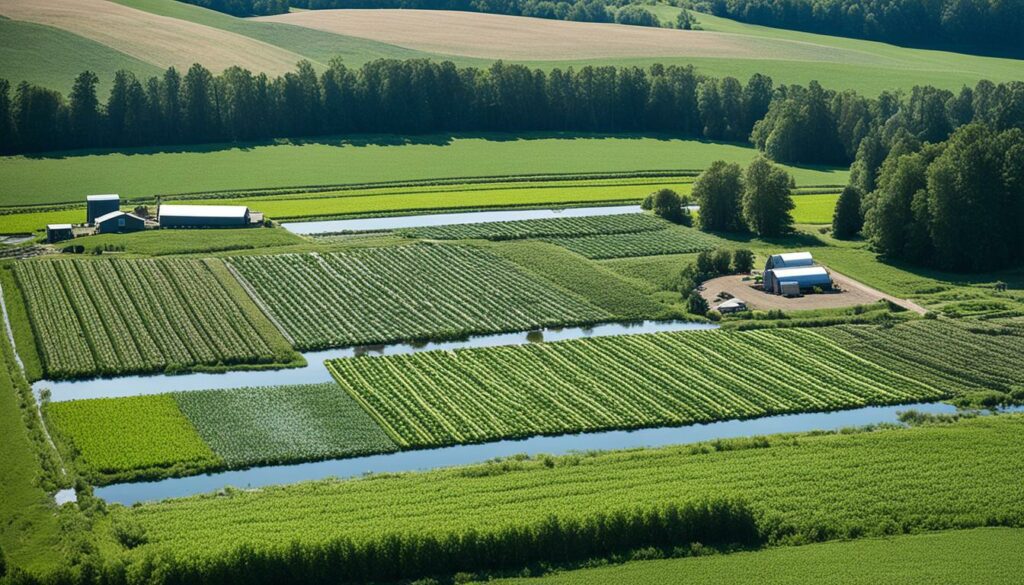
Between 10% and 20% of our total land is used for free-range livestock. Yet, only 1-5% of the food we eat comes from wild forests. Encouraging a variety of plants and animals on farms helps keep the environment and nearly 1.1 billion people in special nature areas healthy. These places are known as biodiversity hot spots.
Farms with many different plants and animals offer homes and food for insects and animals. This helps keep the environment working well, which is vital for growing crops. Some crops that last many years need less chemical help to grow. They are better for the environment but can make less money for farmers.
Keeping many types of crops can increase food and help farms survive different weather. It’s part of a larger plan to use the land and water wisely, following 12 rules. These rules aim to keep the environment diverse and well-managed by many people.
In the end, saving nature around farms needs a lot of work together. It’s important to keep finding new ways to farm that are good for the earth. This helps make sure there’s enough food and that the planet stays healthy.
Ecosystem services are very important for farming. They help keep the farm system going in a sustainable way. This is because they balance the environment, increase farm output, and help farms weather environmental problems. A key part of these services is how they use natural predators. These creatures control pests, which means farmers don’t have to use as many chemicals.
Around a third of the world’s non-sea surface is used for farming. This has a big effect on wider areas. To keep pest numbers down, it’s important to help the animals that eat them, like ladybirds and spiders. California, for example, has lost a lot of its natural habitats. These places used to be home to lots of helpful predators. By bringing back these habitats, farms can do better without needing lots of chemicals.
Cutting back on pesticides is good for the planet and for the farmer’s wallet. These chemicals can harm water and soil, which is not good for the long term. Instead of chemicals, farmers can use natural ways to keep pests in check. They can use things like crop variety and planting different types of crops together. These methods help keep the farm healthy and reduce the need for harmful chemicals.
It’s crucial to boost biodiversity in farms. This supports a large part of our world’s people. The aim is to grow food more but keep nature safe. Using biodiversity-friendly farming methods is key. These ways are being put into practice globally.
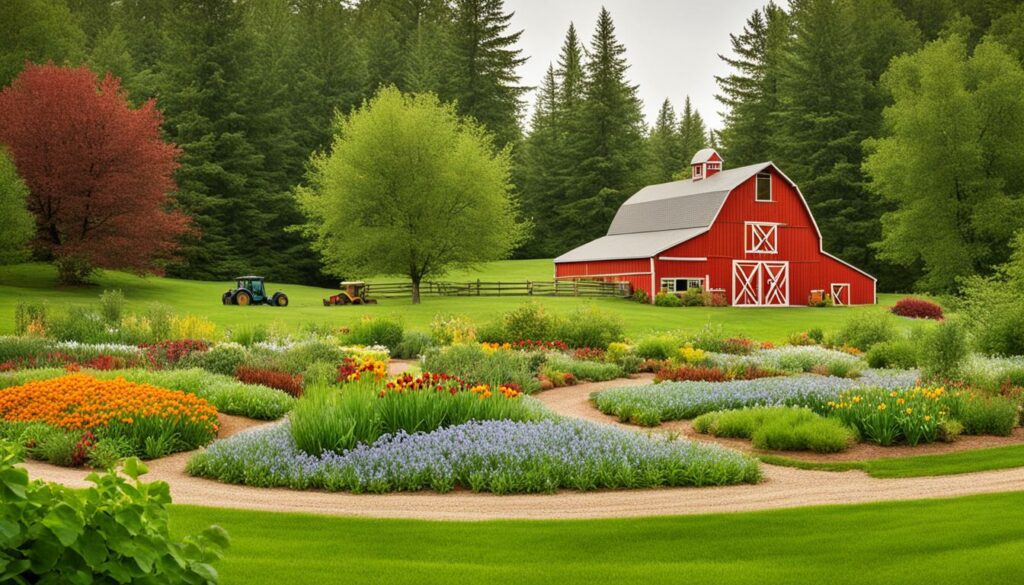
In places like Nicaragua and Honduras, adding cacao plants with other trees helps. It brings good impacts on the economy and the environment. Since 2017, Solidaridad has been working with Cooperativa Salamá in Honduras. They make sure farming helps nature by watching over the area’s variety of life. In Guatemala, they keep an eye on 40,000 ha of palm oil farms. They also look after 2100 ha of special areas, showing they care about the earth.
Changing policies helps with saving nature too. Making money available for nature-focused projects is good. It encourages people to take care of the environment. Incentives for keeping nature like it is and investments to do good can help save more plants and animals in fields.
There are challenges for sure. More than a third of the dry land is used for farming or as pastures. This affects nature a lot. But, by working together and with the right farming ways, we can make our lands full of life and strong. Everyone needs to help, from those working the land to the leaders, to reach our green goals.
Organic farming is key to keeping our plant and animal life diverse. It uses many methods to keep nature balanced. Producers work to make the earth and water better without harmful chemicals. They follow the rules set by the National Organic Program (NOP) to ensure their methods are safe and eco-friendly.
Composting is a central part of organic farming. It involves breaking down natural waste to make fertile soil. This soil is full of life, from tiny microbes to helpful insects. Composting also means farmers don’t need as many artificial fertilizers, which is good for the planet.
Organic farmers mix animals with crops to help the land flourish. By having animals around, they can use natural ways to fertilize and protect their crops. This blend helps keep the land diverse and balanced. It also makes sure the same plants don’t grow in the same place year after year, which keeps pests away naturally.
Here’s a detailed comparison of biodiversity outcomes between conventional and organic farming systems:
| Metric | Conventional Farming | Organic Farming |
|---|---|---|
| Average Increased Biodiversity | 10% | 30% |
| Plant Species Diversity | 5-20% | 20-95% |
| Insect Species Abundance | N/A | 23% Higher |
| Pollinator Populations | N/A | 30% Higher |
Organic farming is more than just about food; it’s about our environment. It makes our farms healthier and helps nature thrive. This method supports a more balanced way of caring for our planet.
Real farms are showing us what it means to farm in a way that loves nature. Massa Organics and Alexandre Family Farm are leading the way. They are changing the face of farms through their smart practices.
In California, Massa Organics is making a big difference. They use smart methods like feeding their animals in a way that helps the land. By growing rice and almonds without chemicals, they protect their farm’s health. They also keep their land safe for wildlife. This way of farming shows us that farm fields are more than just where food grows. They are also homes for many living things.
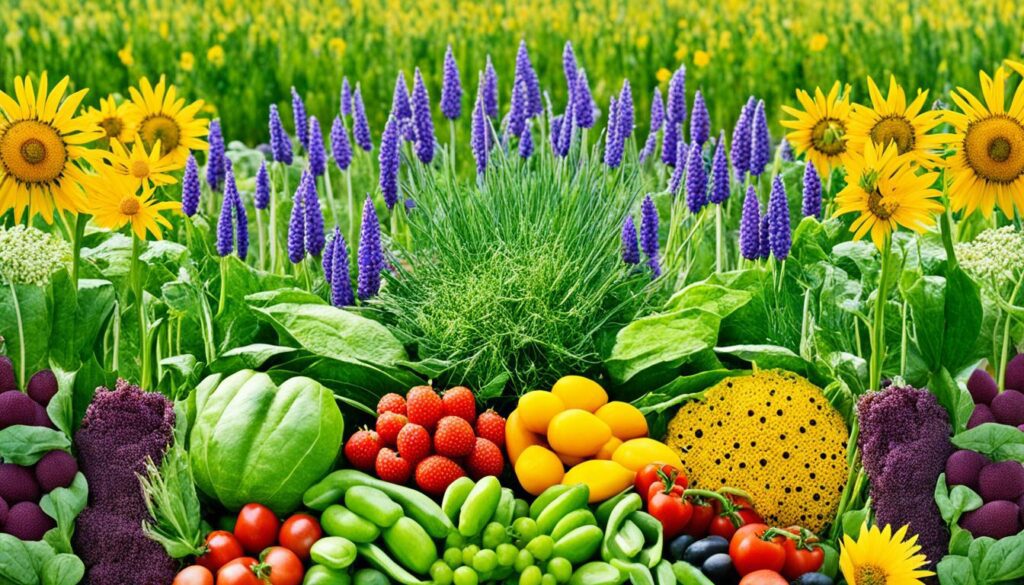
In Northern California, Alexandre Family Farm is doing something special too. They use a smart way of letting their animals graze. It helps their farm have more kinds of plants and animals. Their farm is proof that big farms can help nature a lot.
| Practices | Massa Organics | Alexandre Family Farm |
|---|---|---|
| Holistic Grazing | Implemented | Implemented |
| Crop Diversity | Rice, Almonds, and Miscellaneous Crops | Diverse Grazing Pastures |
| Wildlife Habitat Conservation | Integrated | Integrated |
| Organic Practices | Certified Organic | Certified Organic |
The number of cows on big lands in the US has dropped a lot since 1954. This tells us these new farming ways are very important. Massa Organics and Alexandre Family Farm show us the future of farming. They prove that farms can be full of life while helping to save our planet.
As we move towards better farming, it’s key to blend biodiversity-focused policies and actions. The Kunming-Montreal Global Biodiversity Framework, from December 2022, lists 23 goals for better biodiversity by 2030. This roadmap is crucial for setting up farming laws that support eco-friendly practices.
Europe is prepping to produce more food, which might affect biodiversity on farms. Studies show a non-linear relationship between farming and plant and animal diversity. This means it’s tricky to satisfy food needs without harming nature. That’s why our policies and actions must find a middle ground.
Changing how we use agricultural lands could help a lot. We should mix farms with natural spaces, forests, and communities to boost diversity. But, too much focus on making farms produce more might backfire. So, we need to manage our resources wisely.
The upcoming symposium in Quebec will address these issues. It’s named “Agriculture, Biodiversity and Food Security: From Commitments to Actions.” It’s a key event for suggesting how to make farms more eco-friendly and productive.
It’s vital to share smart ideas before March 2024. There’s an open call for suggestions, with 130 people expected to contribute. Each submission is limited to 1,500 words and should focus on making farming better for our planet.
To sum up, farming needs nature to survive. By choosing the right steps based on solid plans, we can make a farm future that protects our planet.
Our journey into sustainable farming and biodiversity shows how important they are. They’re key to keeping our farms healthy and the lands they use. About a third of the world’s land is used for agriculture. This makes agriculture a major player in the health and survival of our planet’s plants and animals.
Today, our actions affect almost all habitable lands. Over 1.1 billion people depend on farming in places rich in diverse life. With a growing need for farm products, we face a challenge. We must farm in ways that don’t harm the environment. This is to reduce the strain we’re putting on the Earth.
Rights now, farms use 70% of our planet’s freshwater. They also create a lot of pollution, such as too much nitrogen. This causes dead zones in places like the Gulf of Mexico. Farming has also been a big part of making animals disappear at a startling rate. This makes it even more urgent for farms to use and protect biodiversity.
If we keep farming the way we do, by 2030 we’ll need to use even more land. This means we could lose more natural spaces to farming. But, we need the diversity of life in these spaces for our farms to thrive. By farming in ways that protect and use biodiversity, we can make a big difference. This is in making sure we still have a healthy planet for us and all its creatures.
Adding biodiversity is vital in farming. It boosts ecosystem services and creates stronger landscapes. It supports methods that help maintain the environment over time.
The biodiversity crisis is the fast loss of varied species. WWF warns this harms ecosystem services and affects farming’s productivity. It lessens the land’s ability to sustain crops.
Biodiversity greatly helps fight climate change. It stores carbon, regulates water, and keeps soil healthy. This increases the ability of nature to cope with and repair climate damage.
For stable, productive farms, we need certain ecological basics. This includes smart ecosystem management and keeping the soil and plants healthy. It’s key for durable and fertile farming lands.
To manage biodiversity in farming, we use various plans. These include different crops, saving habitats, fighting pests in eco-friendly ways, and following agroecology. They make a more balanced and fruitful farming environment.
Farming should do more than just grow food. It should also protect nature and provide important services. A good farm helps the environment, the economy, and people’s lives.
Switching from one crop to many is vital for several reasons. It improves the variety of plant and animal life, lowers the risk of pests and diseases, and aids the soil and climate. A mixed farm is healthier and more stable.
Rotating crops and covering the soil, improve its health and save water. They also help many useful creatures to thrive. This makes the farming area more vibrant, diverse, and sustainable.
Conservation farming methods like minimal ploughing, rotations, and cover crops help a lot. They keep the soil healthy, protect against erosion, and offer homes for helpful life. This builds a strong and varied farming landscape.
Agroecology looks at the whole farm ecosystem. By balancing nature’s relationships, it helps control pests naturally and keeps the farm stable. It means less chemical use and more biodiversity for the farm’s health.
Examining both artificial and natural farm aids shows how they affect nature and the soil. Natural fertilisers and compost are better for the land, making the farm firmer and less reliant on chemicals.
Reducing how much we dig the soil keeps it strong, holds onto water better, and stops it from washing away. It’s a key part of making the farm’s ground healthy and vibrant for all life.
Creating homes for pollinators like bees helps all crops grow better. These areas not only boost food production but also make the farm more balanced and resilient.
Leaving wild spaces on farms gives many animals a safe place to live. It helps crops by pollinating, controlling pests, and recycling nutrients. This makes the farming area more varied and strong.
Biodiversity grows with diverse crops, less soil disturbance, wildlife-friendly spaces, tree planting, and using organic methods. These steps maintain nature’s balance and make farming last longer.
Insects and birds like ladybirds and spiders eat harmful bugs. By protecting these helpful predators, the farm uses fewer chemical poisons. This keeps the farm and its environment healthier.
To boost biodiversity, we need to set aside wild areas, grow trees among the crops, have many different types of plants, and farm in ways that are kind to nature. These techniques make a rich and diverse farming environment.
Choosing not to use harsh chemicals, rotating crops, adding compost, and having animals on the farm all support many kinds of life. This richness of plants and animals creates a healthy farming system.
Compost improves soil’s structure, feeds it, and makes it teem with life. A strong, living soil is the foundation for good crops and sustainable farming over the years.
Farm animals turn waste into valuable manure, which helps the land and crops grow. This avoids the need for as many artificial fertilisers, benefiting the farm’s balance and output.
Things like Massa Organics and Alexandre Family Farm show how valuable it is to farm in harmony with nature. Their methods bring real and lasting benefits to the land and its products.
To mix biodiversity into farming widely, we should reward nature-friendly approaches, teach about good farming, help farmers switch to organic ways, and manage farms in a more natural style. These steps push biodiversity into the heart of agriculture.